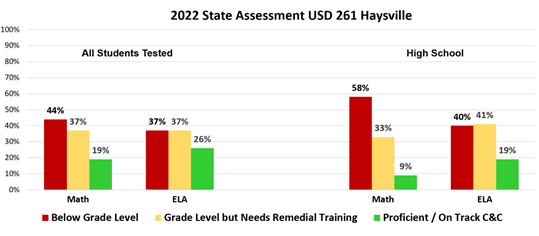A school nurse in USD 261 Haysville was the fifth-highest-paid employee in the district last year, paid over $126,000. That is more than 50% above the average pay for a registered nurse in the Wichita area. Data obtained from school districts in Open Records requests show Schutte’s pay is about double what school nurses make in Kansas, so the Sentinel asked district officials for an explanation. They wouldn’t respond.
Clint Schutte, Assistant Superintendent in Haysville, is one of the officials we contacted, and Beth Schutte appears to be his wife, according to Sedgwick County property records. We also contacted Superintendent Jeff Hersh and school board president Tom Gibson.
Resource allocation is a constant topic of conversation as legislators and parents become more aware of low student achievement in Kansas. Many school districts, including Haysville, barely allocate half of their budget to instruction (face-to-face classroom teaching, lab sessions, independent work, and field trips). This is a crucial element of educating students, according to the Kansas Department of Education Accounting Handbook.
“Although all other functions are important, this function acts as the most important part of the education program, the very foundation on which everything else is built. If this function fails to perform at the needed level, the whole educational program is doomed to failure regardless of how well the other functions perform.” (emphasis added)
Low student achievement in Haysville
Haysville’s stated mission of “the relentless pursuit of excellence” isn’t reflected in its state assessment results.
Among all students tested (grades 3-8 and 10), 44% are below grade level in math; 37% are at grade level but still need remedial training to be proficient, and just 19% are proficient. High school math results are worse, with 58% below grade level and just 9% proficient. English Language Arts results also show more students below grade level than proficient for both cohorts.

The district’s handling of the COVID pandemic led to achievement declines, but proficiency was falling previously. Math proficiency for all students, for example, was at 32% in 2016 and consistently fell each of the next three years, hitting 25% in 2019.
Haysville’s experience of steadily declining outcomes exists all across Kansas, and that isn’t likely to change if the public school system is left to its own devices.
As explained in Kansas Policy Institute’s new book, Giving Kids a Fighting Chance with School Choice, the Kansas public education system – management, not teachers – prioritizes the institutional interests of the system over student needs. The book tells one story after another of education officials consciously deceiving parents and legislators…de-emphasizing academic improvement…and even ignoring state laws designed to improve achievement.
That’s why nothing will change until parents put enough pressure on the Legislature and the Governor to pass money-follow-the-child legislation so every parent can send their children to the school that they believe is best for them.



